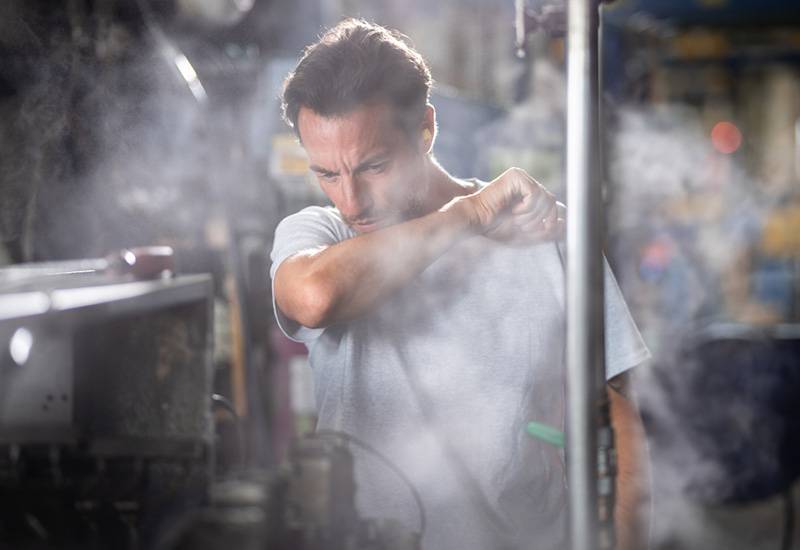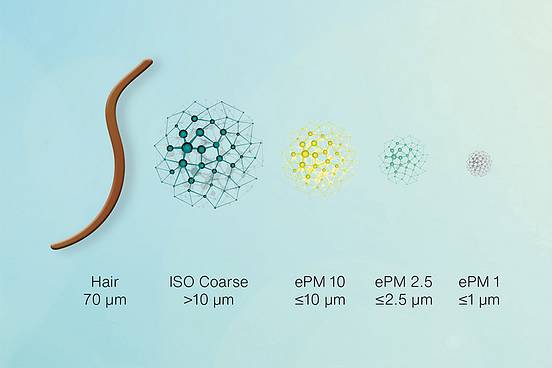Occupational diseases can be extremely insidious, often disguised as a regular cold or mild allergy. But this is precisely why they’re so harmful – because ignoring them at first can lead to worse consequences down the line. That’s why, in this blog, we’re explaining all the different types of occupational disease and how you can prevent them.

Here and there, you might feel a tugging in the arm, a slight urge to cough, or "just" dry skin.
This is because occupational diseases – or illnesses picked up at work – can have many faces., and the most common lung diseases all come down to the same problematic cause – dust particles.
The first symptoms are usually ignored and either blamed on the time of year, your form on the day, a cold or a draught.
But if you and your staff don't take the symptoms seriously early enough, you run the risk of suffering serious consequential damage to your staff’s health, morale and their ability to work productively.
That’s why, we have compiled the four most common occupational diseases, right here.
Lung diseases are never to be taken lightly because of the influence of our respiratory tract on our quality of life. If fine dust is inhaled over a period of time, it can result in problems like asthma, chronic obstructive pulmonary disease (COPD), or allergic reactions.
But it can also cause:
Of course, even though asbestos has been banned throughout Europe for a long time now, we are still observing the long-term effects of its use, indicating just how dangerous certain types of dust can be.

But why are some types of dust so dangerous?
The smallest dust particles (PM1) are so light that they can float in the air and remain there for a very long time. In a windless room they can last for up to 72 hours. In a room where there is no draft, it takes even longer.
This increases the risk of inhaling these fine particles. And as they are so fine, there is a risk that they will penetrate deep into the body and ultimately damage vital organs.
In short:
The finer the particles, the longer they stay in the air, the more likely they are to be inhaled, the greater the health risk.
Yes, even our largest organ, the skin, is not spared from occupational diseases. Contact dermatitis, in particular, is relatively widespread.
Contact dermatitis occurs when the skin comes into contact with irritants and allergens. Whether cement, metals (e.g., nickel and chrome), or resins – the triggers are diverse.
Even latex is considered a common cause of allergic dermatitis. With regular contact, it can become chronic. So, if you have to wear disposable gloves at work from time to time, you are being exposed to a painful potential risk.
But there are also natural causes to skin diseases, such as moisture.
And of course, eczema, sunburn, and skin cancer are also all occupational skin diseases that can occur as a result of poor working conditions (or a lack of employee education). These symptoms are not uncommon, especially in welding shops. In fact, the term "welder's tie" describes the sunburn that occurs when welding between the overalls and the masks of the welders.
Something that happens so often that it gets its own neologism should certainly give food for thought.
Toxins and chemicals can have a bad impact on an employee’s nervous system. And while neurological problems are not the most common occupational disease, the dangers of chemical fumes, pesticides, and other environmental stresses should not be underestimated.
In some cases, these toxins can damage the brain directly or cause numbness, headaches, light-headedness, and fatigue.
Others can cause indirect harm by preventing normal levels of oxygen from reaching the brain. Long term, this can cause migraines and even motor disorders.
There are hardly any jobs that do not require us to use our hands constantly. But unfortunately, using our hands all day, every day, can lead to carpal tunnel syndrome (CTS). CTS can occur when your employees are using vibrating tools or otherwise doing activities that put undue pressure on their hands.
It can cause issues such as:
The pain can eventually extend up the entire arm, and it can cause loss of grip – and in some cases, even cause thumb muscles to waste away.
The fact is, most occupational diseases are preventable if suitable protective measures are taken (in good time). That’s why it’s important to make your employees aware of the symptoms mentioned (e.g., through training) and remind them of the importance of consulting a doctor as soon as they suspect an occupational illness.
But the most effective way to protect your employees from occupational diseases is by using air purifiers that ensure particles (such as fine dust) cannot be inhaled in the first place.
The result?
The right air purifiers can give you up to 50 % less sick leave in your company and protect your employees from developing occupational diseases. Contact Zehnder Clean Air Solutions to find out more today.